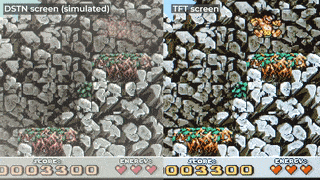If we put the repair/restoration things aside for a moment, it might be worth explaining what was so innovative about TFT technology used for the first time in this laptop, over 30 years ago.
Color LCD screens did exist before this laptop was created, in the form of of passive, or Dual Scan Supertwist Nematic screens. And, unfortunately, the image they produced was absolutely awful, especially when there was any kind of motion on the screen. The ghosting was so bad, sometimes even several seconds long, that these screens were completely unusable for multimedia tasks or games. The colors, contrast and image brightness uniformity was also really poor. I had experience with old DSTN laptops and I can confirm that they were really bad. Even using mouse could be a problem, because the cursor would usually be invisible during motion, because the screen couldn't refresh the image quickly enough.
Currently I don't have a DSTN screen that I can use to show a comparison with TFT, but I simulated one, by post-processing a recording of TFT screen and adding ghosting artifacts (which in real life could be even worse than that) and modifying the colors and lighting, according to what I remember from my experience with DSTN screens. If you have never seen a DSTN screen before, this should give you an idea what is the difference, and how much of an improvement was the TFT technology.

Discussions
Become a Hackaday.io Member
Create an account to leave a comment. Already have an account? Log In.